Continued from yesterday”¦ When it looked like the rain had slowed down, we ventured out and caught the bus. It turns out we caught the right bus, but going the wrong direction. Oops. We decided to ride it out, knowing that sooner or later it would get us to the Castel. This was not a good of an idea as we originally thought, since it took us way out of downtown. At least we were warm, out of the rain and got to see more of the city than we could on foot. Rome has a lot of nice looking churches, buildings, and sculptures all over the city. After an hour, the bus turned around. Hmmm”¦ it would be at least an hour back to the Castel. We saw a subway station and hopped off the bus and onto the subway, knowing the subway would get us there in minutes. From the subway, we needed to catch another bus. We again caught the right bus going the wrong direction. As soon as we figured it out, we immediately got off and waited for the right bus. When we did finally make it to the Castel, we were relieved. The only real reason we used public transit was so we didn’t have to walk in the rain, but when all is said and done, we probably spent more time in the rain waiting on busses.
The Castel was originally built by Emperor Hadrian as a mausoleum for himself and his family, with construction beginning in 128 AD. We approached the Castel from the back, which is too bad. The entrance from the front is stunning. Hadrian had built a fancy bridge in 134 AD as an impressive entranceway to his mausoleum, now called the Ponte Sant’Angelo. In the 17th century, Bernini and his pupils sculpted big, impressive statues of angels to line the bridge.
In the 6th century AD, the Castel was converted to a fortress for the popes. From the outside, the Castel looks similar to the other fort/castles we have been to. A dry moat surrounds the exterior walls (except along the riverfront). The rectangular shaped walls are tall and imposing, with the zig zag pattern at the top, with turrets in each of the corners. Sticking out from behind the walls is a big round brick building. The lower portion of the round tower is the original mausoleum. The upper portion of the tower, the exterior walls, corner turrets, and so forth were additions made slowly over time by subsequent popes. The Castel actually did get used for its intended purpose. In the 16th century, Rome was sacked by Emperor Charles V and hundreds of people lived in the fortress for months.
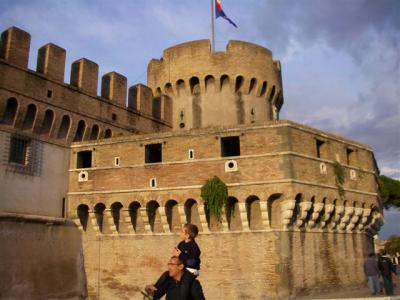
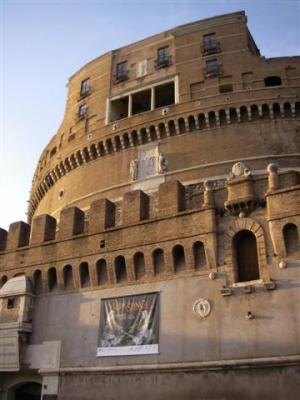
We entered the complex through the large and foreboding doors. There are buildings all along the inside of the main protection walls. The ticket booth and gift shop are in those buildings, among other things. There is a sizeable gap between the buildings along the wall and the round tower in the center. The tower walls are smooth and windowless, with just one little door that we saw. The gap is a walkway that goes all the way around the tower.
It was 1800, so the first thing we asked was when they closed. If they closed right away, we’d skip going inside. They told us they closed at 1930. We had no idea how big the castle really was, but we figured an hour and a half would be enough time to at least skim through most of it.
We went inside the little door and down a sharply sloping ramp that maybe equates to a one story staircase. At the bottom of the ramp was an Egyptian artifact. From there, you are inside tunnel, walking up a gently upward sloping walkway. The tunnel goes around the entire circumference of the tower, and seems to go on forever. In Hadrian’s day, the floors were mosaics and the walls had marble facades.

It finally lets out in a chamber with huge ceilings. This is where the ashes of Hadrian and the rest of his family were buried. This is probably the end of the original mausoleum structure. There is a ramp that runs through the middle of the room, straight up at a sharp angle from the tunnel to a doorway cut up near the ceiling. The ramp was obviously an awkward later addition. Something about being in a burial chamber with mysterious tunnels leading to a room with high ceilings and a sharp upward ramp kind of reminded us of being inside the pyramids.
The doorway led into a courtyard surrounded by several buildings. You could either go into the buildings from here, or out to the lower terrace, a walkway on the other side of the buildings that winds around the outer ring of the tower and has nice views of the city. The first shot is the courtyard, the second shot is the walkway, the third shot is the Ponte Saint’Angel bridge taken from the walkway. From the walkway, you can look down at all the turrets. They still have canons, catapults, and cannonballs set up on them.
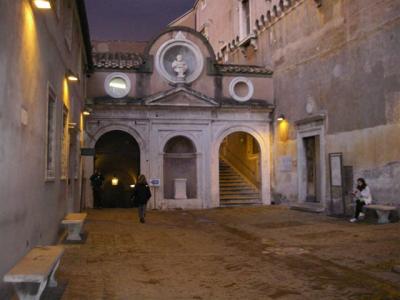
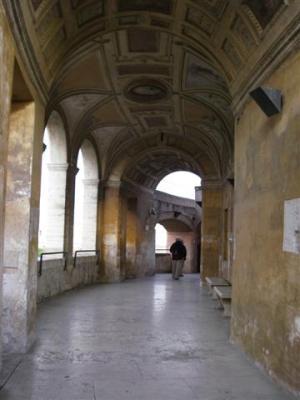
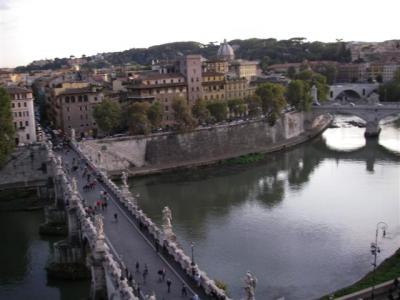
Inside the buildings there were a couple of traveling art exhibits. One is about the Egyptian influence on Roman art. Apparently, Egypt mania swept the nation, and for a while, every household with any kind of money and/or influence had to have an Egyptian room. This is the era when so many of Egypt’s treasures were pilfered. There were many examples of Roman artists incorporated the Egyptian style into their artwork. For example, there were several pieces where Roman nobility and leaders are depicted in Egyptian attire. Most of the things on exhibit were manuscripts, paintings, and sculptures. There was a movie playing on the subject, but we didn’t stop to watch it. The rooms the exhibits were in were in the Vatican style, with ceilings and walls intricately painted.
The second exhibit was modern art, we think all from the same artist. Each display incorporated mannequins in interesting settings. It was creative. The rooms were completely plain, with white walls and virtually no decor.
A couple sections of the castle had a small handful of historic pieces on display, mostly of armor and weaponry, guns and swords and helmets worn in the medieval days. The rest of the tour was just seeing what the castle looks like. Most of the rooms were not open, but quite a few were. Many of the rooms on display have Vatican style décor, with intricate and opulent art on the walls and ceilings. Other rooms were surprisingly plain, not adorned at all. Another surprising thing was how many corridors there were. It seemed like a lot of wasted space to have so many hallways.
We saw the treasury room where the Vatican used to house its physical wealth. It is a relatively small round room in the center of one of the floors, so there is no way to access it directly from the exterior. The walls are lined with cabinets and in the center of the room sit some really big chests. In 1277, a passageway was built from the Vatican to the Castel so that popes could flee to safety if they were threatened at the Vatican. It was also a good way to safely transport wealth.
We went up another flight of stairs to the top terrace. It is basically just a flat topped roof, and it offers nice views of the whole city. It was sunset, so it was an especially nice time to be up there, getting to see the sun go down over the city and the lights come on. We are pretty sure the big dome in this shot is St. Peter’s Basilica.
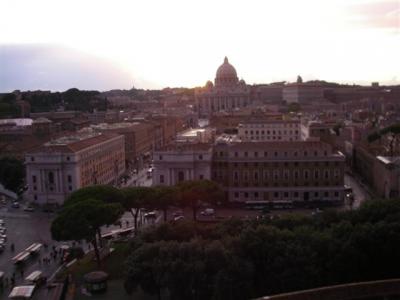
We were pleased to see that we had powered through the Castel in only 45 minutes, which meant we had another 45 minutes to go take a closer look at some of the exhibits. We went down the stairs to the lower terrace. The staff in every building we tried to walk into told us they were closing and were ushered out. Bummer. We did dilly dally around before actually leaving the grounds, probably more to be stubborn about being pushed out so early than anything else. We walked all the way around on top of the outer fortress walls, walked around the lower walkway between the walls and castle for a bit, and checked out some little nooks and crannies in various corners before finally making our way to the exit.
It was raining pretty hard now. There was a bus stop just across the road. We ran over there and quickly caught a bus, with no clue where it was going. We used the logic that sooner or later it would pass a metro station and that once on the subway, we could easily navigate back to the boat. We got another tour of Rome, and this bus took us to completely different areas than the last bus had, which was good. We had been on the bus an awful long time and were getting nervous that our plan may have backfired when a big M sign appeared. Phew.
We found out that at the shore it was even colder and windier than in Rome. We froze our butts off walking from the bus stop to boat. And we were relieved to see Kosmos was just fine.
